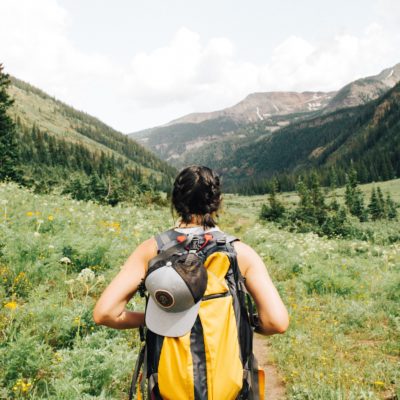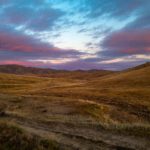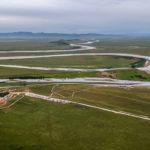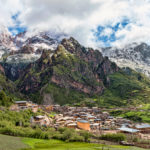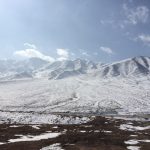1) Backpack
First thing you’ll need for your day hike is a decent backpack. You can get away with using an old JanSport from your closet if you are packing light, but if you are serious about hiking, you’ll want something a little more robust.
For size, a typical day hiking pack will range from 20-35 liters. This is enough to hold your extra layers and all of the other day hiking essentials that we talk about below. Other features you’ll be looking for when you choose a day pack are:
- Interior pocket for a water bladder (which makes drinking easier)
- A hip belt that will place the load on your hips rather than your shoulders
- A sternum strap which prevents the pack from shifting when you are hiking
Your best bet is to try a pack on in the store to make sure it’s a good fit for your torso and body type. Here are a few of my favorite day-packs that I’ve used over the years:
- Osprey Mira 22 Hydration Pack – This pack is a great all-around day pack and I took a similar Osprey Hydration Pack with me to Everest Basecamp and to Canada last summer. It’s got a 2.5-liter hydration reservoir, lots of pockets, and a comfortable hip belt.
- Mindshift Gear Rotation 180 Horizon 34 Backack – This is the best camera backpack I’ve come across for hiking and other outdoor actvities. If you are a photographer who is sick of taking off your pack every time you want to snap a photo, this pack is for you. The part of the bag that holds your camera and lens rotates around to the front of your body, while the pack stays in place. It makes it very easy to access and takes a lot of pressure off of your neck if you are used to hiking with your camera swinging across your body. I used the Mindshift Gear Rotation Pack all ski season this winter and can’t wait to hike with it more this summer.
- Osprey Raven 14 – This is a much smaller pack that I use for biking and dayhikes when I don’t need to bring a ton of extra gear. It’s a frameless bag with an awesome mesh back panel for ventilation. My favorite thing about this pack is the separate compartment for the included 3-liter hydration reservoir that makes it very easy to refill your water. It also has a few different pockets for snacks, a small camera, and extra layers.
3) Sun Protection
To shield your skin from the sun while you’re hiking, bring along a bottle of sunscreen that is at least UPF 30 and won’t come off when you sweat. Also pack a breathable brimmed hat and sunglasses that aren’t fragile enough to break for eye and face protection, too. While these might be obvious for hot and sunny hikes, it’s not as commonly known that going for a hike in the snow on a sunny day can also cause sunburn from “snow blindness”. During winter hikes the sun reflects off the snow and sends some pretty strong rays back at you. Sun protection is a day hiking essential that will help you to prevent injury. Here are some of our favorite essentials for sun protection
4) Map / Navigational Tools
There are alot of great websites and apps for finding trails. We highly encourage you to have a few of these downloaded on your phone. For navigation, Gaia is one of our favorite GPS apps that allows you to see your location in real time on your phone.
While many people rely solely on their smart phone’s advanced GPS to navigate on a trail, it’s important to have a good backup. In the outdoors, there are plenty of places where there is no WiFi connection or cell reception and unlike a map or a compass, the battery can die. If you happen to get lost and find yourself with a dead smartphone then that could be a real safety concern. So, always pack the appropriate waterproof and tear-proof map, plus, a compass to help you find your way.
If you want to opt for a navigational tool like a handheld GPS, then go for it! There are a lot of great options out there, like the Garmin InReach, which is sturdy enough to take with you and also serves as a backcountry communication device….But either way remember to bring your map, so you don’t have to rely solely on battery-operated gear.
5) LOTS of Water
Your body needs water to function at its very best. Bringing extra water, and even a water purifier for long hikes, in case you run out is a really important day hiking essential to have while you’re out there bagging peaks. In any weather, staying well hydrated can help you avoid dehydration or even altitude sickness, but moreover, it simply helps you feel good and have fun.
Many daypacks have space for a hydration reservoir which can be filled with water and allows you to drink from an attached tube. Since it’s nestled in between you and the pack, it’s easy to carry and is a great option for staying hydrated on-the-go. An alternative to a hydration reservoir is storing one or two lightweight water bottles in the side pockets of your backpack for easy access.
6) Energizing Snacks
Bring enough food for the day to stay full and keep your energy up, plus extra to be safe. Nutritional snacks that are packed with protein and fiber are best, so grab some granola bars, jerky, sturdy fruits and veggies like apples or carrots that won’t get squished in your bag are great. Or even bring a good ol’ peanut butter and jelly sandwich.
It’s important always to make sure you have enough food, but the point of having extra is really in case of an emergency. You’ll also be burning more calories than you might be used to. So, don’t skip this step and load up on the food.
7) First Aid Emergency Kit
It’s a good idea to invest in a portable and lightweight first aid kit that you can always keep in your backpack with your other day hiking essentials. While it’s unlikely that you will have an emergency, things like blisters, cramps, and minor cuts can happen. The Adventure Medical Kit Ultralight/Watertight .7 First Aid Kit is a pre-made first aid kit that has the basics for dealing with minor injuries. If you go this route, make sure you are familiar with what’s in it, and adapt the kit to your personal medical needs as necessary.
We also recommend throwing a lighter or waterproof matches into your first aid kit in case you get caught after dark and need to build a fire, as well as a small whistle that you can use to garner attention in an emergency.
8.) Flashlight or Headlamp
In case that you get caught on the trail after dark, you’ll want a source of light to help you find your way back to the trailhead. Carry a headlamp with you for hands-free light or a small and lightweight flashlight if you don’t have a headlamp. Make sure the batteries are charged, too.
9) A Multi-Tool & Mini Repair Kit
A mini repair kit will help you fix something like a tear in your backpack, a broken strap or any other unforeseen issues that may come up while you’re out there. While the contents of repair kits can vary between products, it’s always good to have multi-purpose tools with you like a pocket knife, repair patches or strips of the ever-handy duck tape. A good tip is to place strips of duck tape on your water bottle or trekking poles to rip off in case you need to repair something in a pinch.
10) Trekking Poles
Trekking poles might not be considered a “day hiking essential,” but if you are a beginner hiker or you are tackling steeper, more challenging terrain, trekking poles can be extremely helpful. Trekking poles take pressure off your knees, give you more power on the ups, and help maintain a rhythm while you’re hiking. Check out this list of our favorite trekking poles and a more detailed explanation of their benefits.

